Mazda introduced the CX-5 as a 2013 model and updated the compact crossover's exterior styling, interior materials, sound insulation, and advanced safety tech for the 2016 model year. Usually such a comprehensive freshening would mean no full redesign until at least 2018, and more likely 2019. But even with the updates (which yielded good reviews and record sales) Mazda felt it could and should further improve the CX-5, and as soon as possible. So they've fully redesigned the compact crossover for 2017, a year or two ahead of the typical schedule.
What could Mazda do that they hadn't already done with the 2016 updates? For years they'd fared well with auto reviewers, but not nearly as well with the typical American car buyer. A puzzle they desperately need to solve if they're to remain independent.
Have they?
One reason Mazda opted to redesign the CX-5 so soon: competitors haven't been standing still. Honda also redesigned the segment-leading CR-V for 2017. Chevrolet and Volkswagen have redesigned the Equinox and Tiguan (respectively) for 2018. If Mazda wants to get to the average car buyer, it'll have to out-design and out-engineer these much larger companies.
Have they? Let's find out!
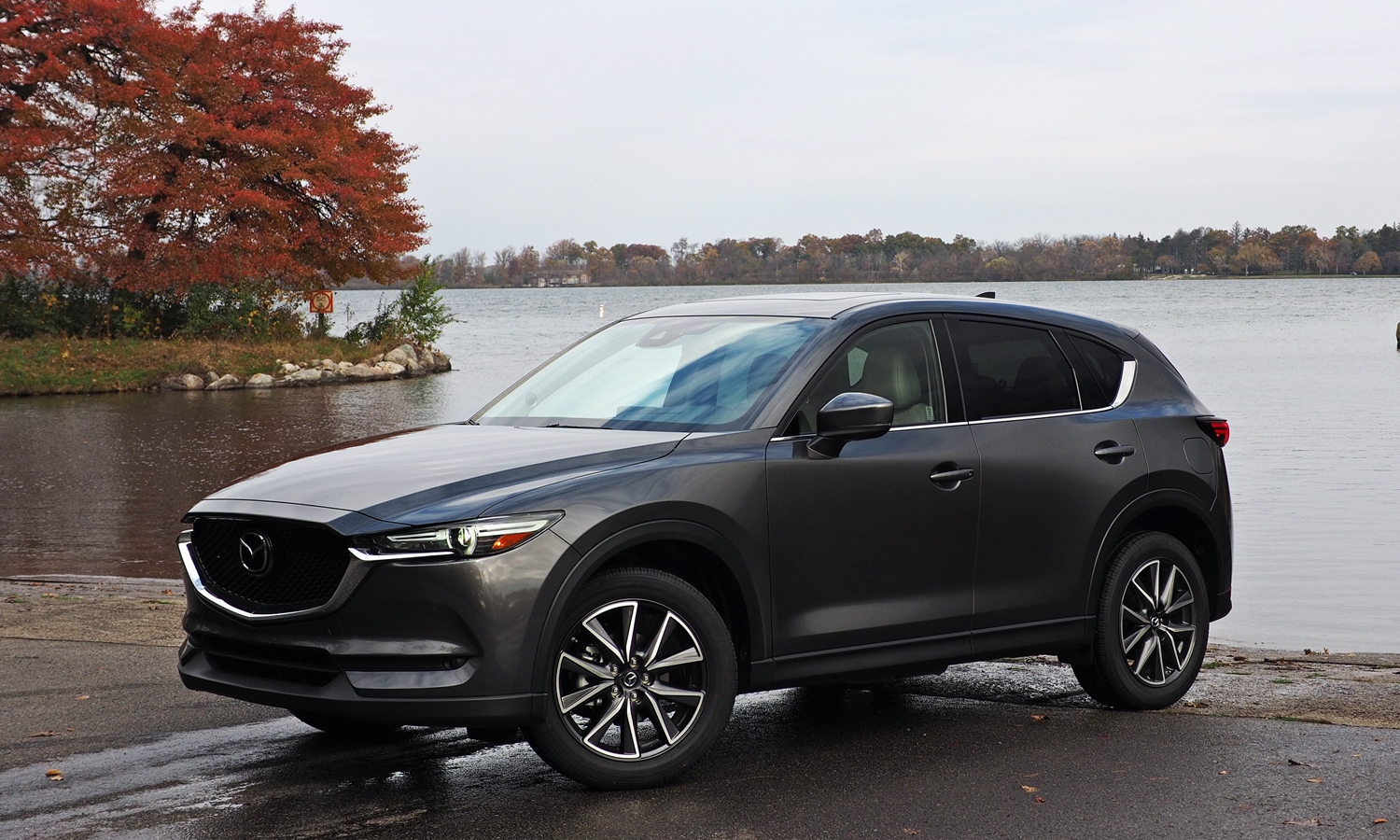
Cleaner, more elegant body sides on the second-gen CX-5. Dramatic curvy character lines deleted. more CX-5 photos
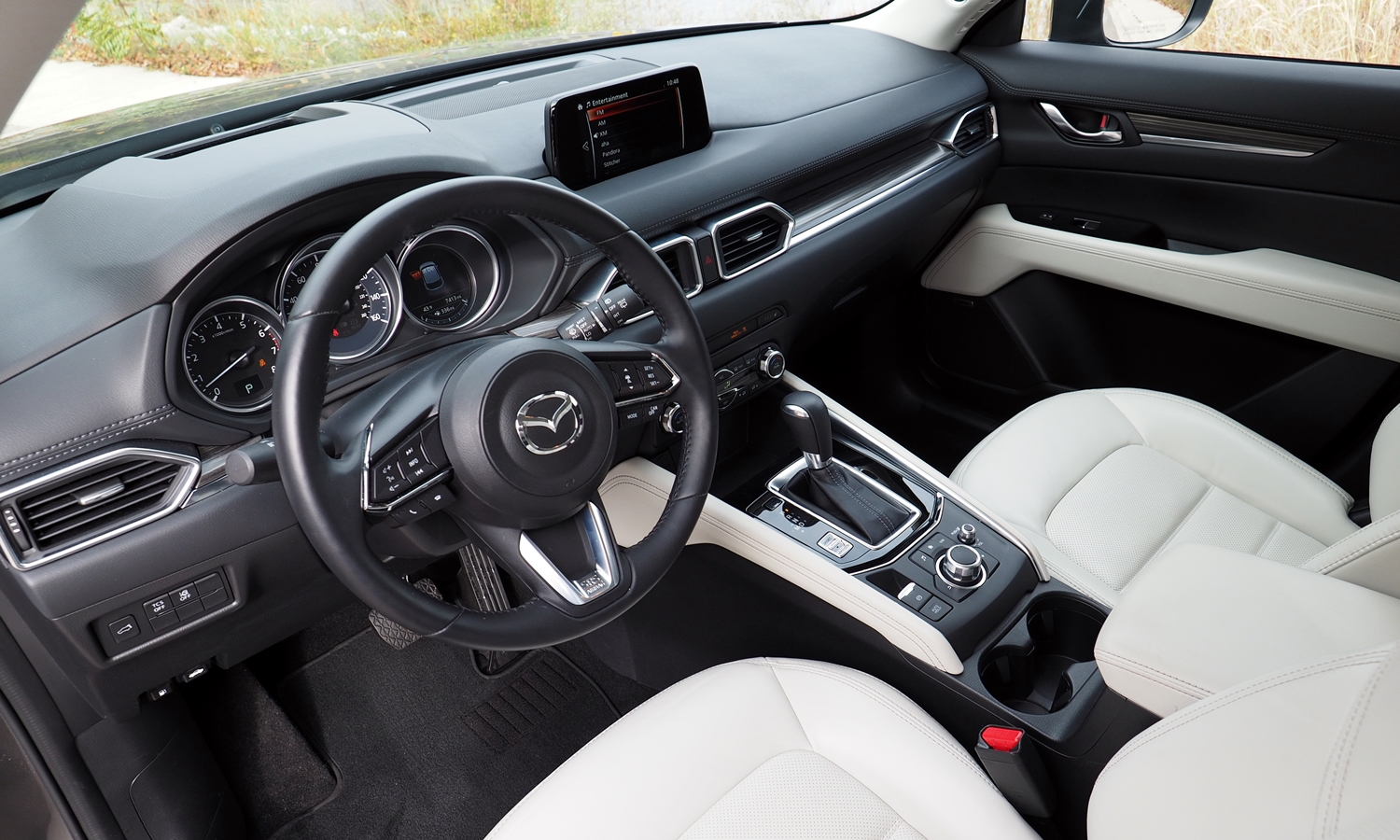
Far more upholstered and stitched surfaces than you'll usually find at this price point. Very nice.
| |
Compared to the CR-V |
| Exterior styling |
 Better
Worse
Better
Worse
|
At a glance, the second-generation Mazda CX-5 looks much like the first-generation Mazda CX-5. Look closer, though, and you'll find that Mazda has thoroughly refined the crossover's lines and taken its appearance upscale. The new, much slimmer headlights in particular appear more sophisticated. If there's any fault to be found with the updates, it's that the new, more cleanly styled CX-5 might look a smidge less sporty than the old one.
The new CR-V, like other current Hondas, appears overwrought. It's trying far too hard to appear stylish and exciting (it's neither). The new Equinox would be utterly forgettable if its fenders didn't awkwardly hunch up over both the front and rear wheels. The Tiguan still looks like a VW--tasteful but not especially artful and far from exciting.
| Interior styling |
 Better
Worse
Better
Worse
|
As good a job as Mazda's designers did with the new CX-5's exterior, they did their best work inside the crossover. Here as well they kept the same basic styling as before, but took it in a considerably more upscale and sophisticated direction. Far more of the instrument panel, door panels, and console is upholstered and stitched than in competitors. The resulting ambiance might not quite be up to that of a $50,000 European compact crossover, but it shouldn't even be in the same ballpark. Yet it is.
One bit of the interior betrays the Mazda's actual price: the infotainment display is on the small side for one in a recently designed vehicle. The instruments could also be fancier, though there's something to be said for the clarity and simplicity of the Mazda's classic white-on-black dials over the Honda's digital light show.
By current Honda standards, the CR-V's interior styling is restrained and tasteful. But it's not as stylish as the CX-5's and far more of its surfaces are hard plastic.
Like Mazda, Chevrolet has adorned the new Equinox's instrument panel with some upholstered-and-stitched trim. But the overall ambiance of the cabin is more generic and functional than upscale. It's not a bad interior--actually it's pretty good--but it is a boring one.
The new Tiguan's interior seems the most plasticky and downscale of the bunch. In comparison to other current VWs, it's much more designed-for-America Jetta than designed-for-Germany Golf. If you want a fancy interior, Volkswagen wants you to buy an Audi.
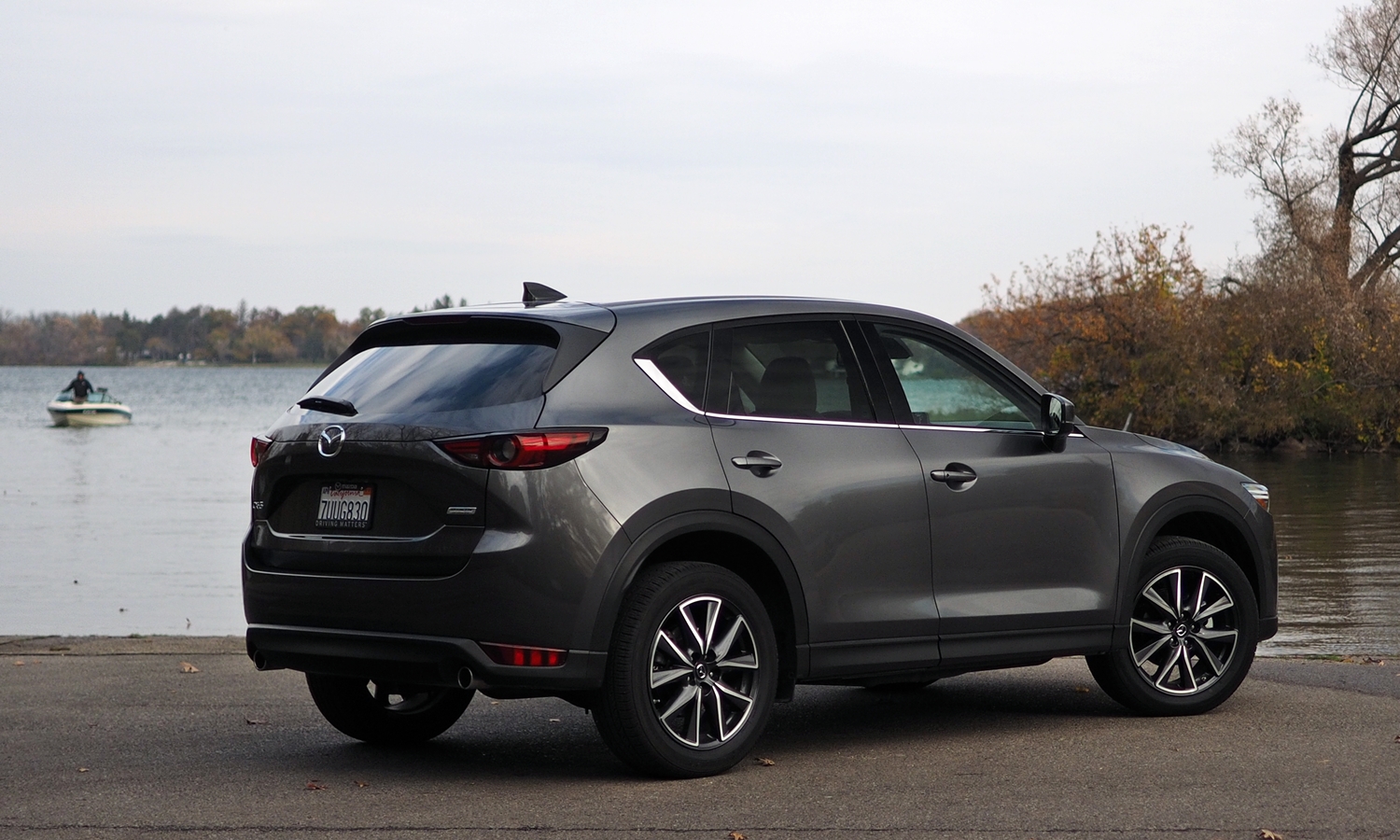
Truncated tail. Elegant and sporty, but not good for cargo-hauling capacity.
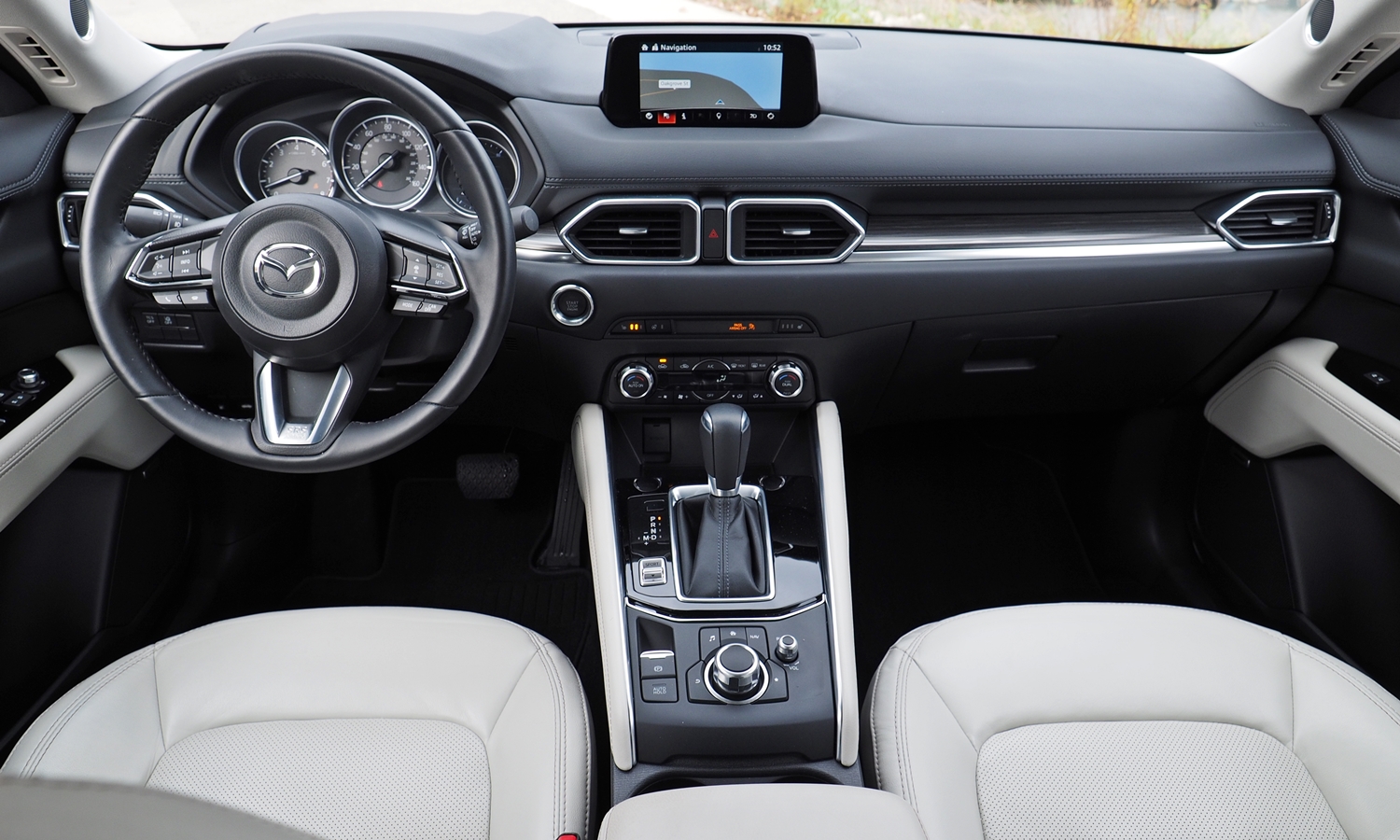
The instrument panel looks compact. It is compact. Note stitched surfaces and artful vents.
| Handling |
 Better
Worse
Better
Worse
|
Handling...is relative, especially in this case. Compared to a well-tuned lower, lighter hatchback (such as the Mazda3 or VW GTI) no crossover in the Mazda CX-5's class feels agile or sporty. While some premium-brand compact crossovers (most notably the Jaguar F-PACE and Porsche Macan, likely the Alfa Romeo Stelvio as well) have become quite fun to drive, the secret formula hasn't trickled down yet. But compare the CX-5 to its direct competitors along a curvy road, and the Mazda handles more tightly and precisely. Under load the steering feels well-weighted and provides good feedback. The harder you press the new CX-5 (up to a point), the better it feels.
In aggressive driving the CR-V's suspension feels tightly damped, but it rolls more, its steering feels vague, and its tires start squealing much sooner than the Mazda's. The Chevrolet Equinox with the 1.5T engine feels larger and heavier than it is (a traditional trait of GM's compact vehicles) but otherwise handles capably, if not engagingly. The Tiguan's quick steering helps it feel agile, but the VW loses its composure when pressed and feels much less polished than the others.
Still, in absolute terms and in typical day-to-day driving the CX-5 isn't all that engaging. Mazda should consider providing more aggressive chassis tuning as an option.
| Quietness |
 Better
Worse
Better
Worse
|
While the Mazda CX-5's steering and handling have improved only marginally with the 2017 redesign, its ride quality, noise levels, and overall refinement have improved dramatically. Though some mildly imperfect road surfaces induce small but fairly sharp vertical reactions from the CX-5's suspension (a common sportyish crossover issue), the Mazda otherwise rides smoothly. Aside from some buzziness from the engine when worked, noise levels are almost premium-vehicle low.
In general the new CX-5 feels more solid and more polished than the old one. This is perhaps most obvious when closing the doors, a time-honored test in which past Mazdas, engineered for minimum mass, often haven't performed well. Among competitors, the Equinox might have a smoother, quieter ride, but the CX-5 has an edge over the others.
| Price or payments |
 Better
Worse
Better
Worse
|
So, how much more is all of this improved ambiance and refinement going to cost you? The base price (with an automatic transmission) has increased by $490, to $24,985, but this seems extremely reasonable given the improvements, the much weaker, 2.0 liter engine fitted to the base 2016, and (burying the lede) additional standard features on the 2017 that are worth about $1,000.
Load up both the 2016 and the 2017 and the latter actually costs $1,790 less despite including additional content worth about $850, for a feature-adjusted price difference around $2,600. The 2017 would be a far better value even if didn't appear more upscale and feel more refined.
The Premium Package available on the Grand Touring includes features not even offered the previous year: memory for the driver seat, a power passenger seat, heated steering wheel, heated rear seat, and head-up display.
Of course, the 2017 CX-5's serious competition isn't the 2016, but compact crossovers from other auto makers. Honda has been pricing its vehicles aggressively, but they don't undercut Mazda in this case. Both the CX-5 and the CR-V start at $24,985, and the Mazda has about $1,000 in additional standard content. Load up both the CX-5 and the CR-V, and the Mazda's sticker undercuts the Honda's by $1,020, $33,465 vs. $34,735. Features you can get on one but not on the other pretty much cancel out.
The new 2018 Chevrolet Equinox is far more expensive than either. Load up both it and the CX-5, and the latter costs over $5,000 less. The additional features offered on the Equinox (e.g. a panoramic rather than a regular sunroof, cooled front seats, around-view camera system, rear obstacle detection, OnStar) account for only about $1,000 of the difference. Add the turbocharged 2.0-liter engine to the Chevrolet, and the gap widens further.
The CX-5 similarly undercuts the new 2018 Volkswagen Tiguan, but in this case feature differences--most notably the VW's third-row seat--narrow the gap to about $2,000.
Against these competitors the new CX-5 is very attractively priced.
| |
Compared to the CR-V |
| Powertrain performance |
 Better
Worse
Better
Worse
|
Why not buy the new Mazda CX-5? There aren't many good reasons.
The most obvious: if you want effortless or adrenaline-inducing acceleration in your compact crossover, Mazda doesn't offer it. While Chevrolet, Ford, and Kia offer turbocharged 2.0-liter engines with from 235 to 252 horsepower, Mazda does not. The only engine offered is a non-turbocharged 2.5-liter good for 187 horspower.
Mazda should strongly consider offering the 250-horsepower (on premium, 227 otherwise) turbocharged 2.5-liter four-cylinder engine introduced in the three-row CX-9 and soon to be available in the Mazda6 sedan in the CX-5 as well.
With its 187-horsepower engine, the CX-5 can accelerate as quickly as most people will ever need it to, with a zero-to-sixty time in the low eights. But the engine never feels strong and its mild buzziness can seem out of place in an otherwise highly refined vehicle. Thrill-seekers will not find what they are seeking.
The new CR-V can get to 60 mph about a half-second sooner, but its 190-horsepower turbocharged 1.5-liter engine is much harder on the ears than the Mazda's in the process. That this engine is hitched to a CVT programmed to hold engine speed fairly steady (near the point of maximum power and maximum din) even as vehicle speed increases has objective advantages but subjective disadvantages.
The Equinox is significantly slower than the other two with its 170-horsepower turbocharged 1.5-liter engine, but significantly quicker than they are with its 252-horsepower turbocharged 2.0-liter engine.
The Tiguan disappoints most in this area. Its 184-horsepower turbocharged 2.0-liter surges and lulls at part throttle when cold, isn't at all enjoyable to rev, and sounds downright agricultural. It seems to share nothing with the much stronger, much more refined turbocharged 2.0-liter engine employed in many other Volkswagens and Audis.
The CX-5's manually shiftable six-speed automatic transmission makes the most of what its engine can provide, without the adverse effects of VW's CVT. This transmission tends to shift smoothly and promptly into whatever ratio the situation calls for. Its only shortcoming: sometimes during or after spirited driving it will hold a lower gear longer than it really needs to. A "power" mode makes the transmission even more aggressive at the expense of holding low gears even longer.
Want a manual transmission? Well, with the redesign the CX-5 joins its direct competitors in not offering one.
| Cargo capacity |
 Better
Worse
Better
Worse
|
If you want the compact crossover capable of carrying the most cargo, the Mazda CX-5 isn't it. You can stuff far more of your stuff into the Honda CR-V, Nissan Rogue, Subaru Forester, Toyota RAV4, or Volkswagen Tiguan. Blame the Mazda's relatively long hood, relatively short tail, and sporty stying.
While cargo volume specs should only be compared with much caution--different methods can yield vastly different results--the official numbers for the CX-5 and CR-V seem to accurately reflect the real-world difference between them. With the rear seats up, the Mazda can carry 30.9 cubic feet, the Honda 39.2. With the rear seats folded the figures are 59.6 and 75.8 cubes, respectively.
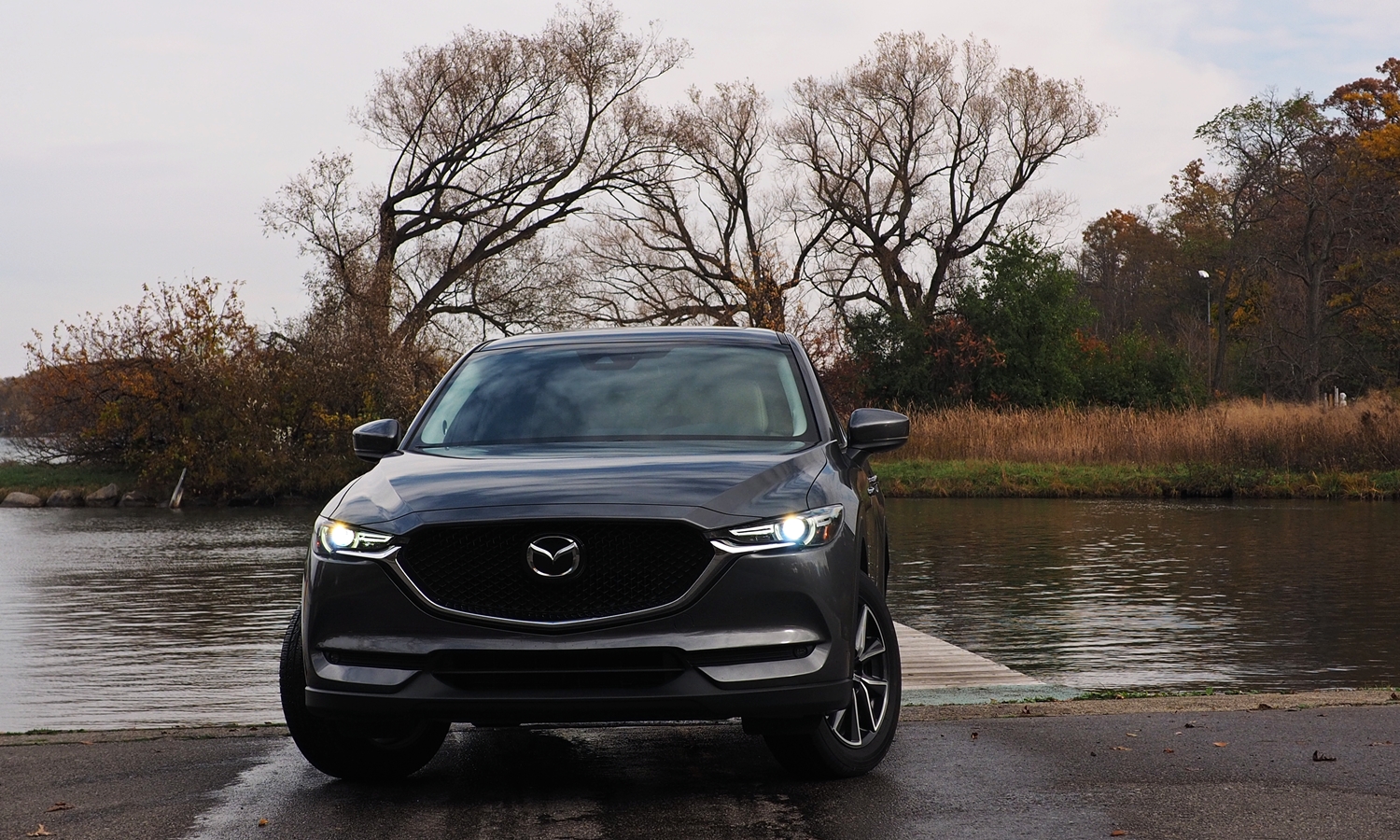
Thinner, more elegant headlights and a broader, classier grille distinguish the second-gen CX-5.
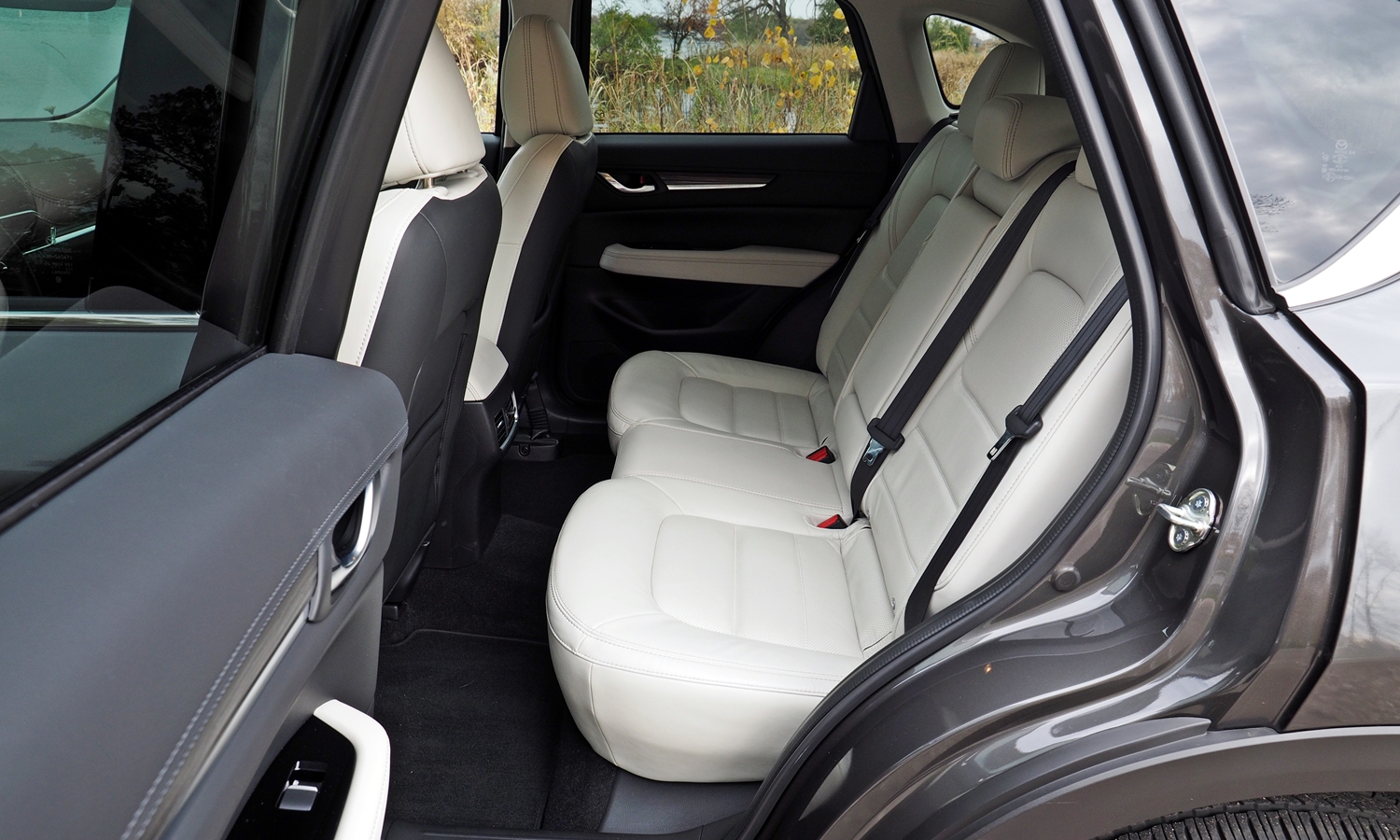
The Mazda's rear seat remains much less roomy than the Honda's.
| Rear seat room & comfort |
 Better
Worse
Better
Worse
|
There's enough room for four adults inside the Mazda CX-5. But the Honda CR-V and some others are considerably roomier.
Want an occasional third-row seat? While Nissan and Volkswagen offer one in their compact crossovers, Mazda does not.
| Front seat support & comfort |
 Better
Worse
Better
Worse
|
Move to the front seat, and room and comfort inside the Mazda CX-5, while not bad, could be better. In the Honda CR-V you sit higher inside an airier interior.
Seat comfort is nothing special in either crossover. The Mazda's driver seat could feel more contoured and could provide much more lateral support. Combine the latter with slippery leather seating surfaces, and you're much more likely to slide taking curves at speed than the car is.
| Audio & nav systems |
 Better
Worse
Better
Worse
|
Mazda's audio system still does not support Android Auto and Apple Carplay. Those of most competitors do.
| |
Compared to the CR-V |
| Fuel economy |
 Better
Worse
Better
Worse
|
The Mazda CX-5's fuel economy is quite good compared to past compact crossovers. But the competition hasn't been standing still, either, and some manage better EPA figures than the Mazda.
With front-wheel drive the CX-5 rates 24 mpg city and 31 mpg highway. All-wheel-drive knocks off one mpg in the city and two on the highway. The redesigned-for-2017 Honda CR-V achieves 28/34 with FWD and 27/33 with AWD, a significant three-to-four mpg better than the Mazda.
The 2018 CX-5 will score about one mpg better than the 2017 thanks to the addition of cylinder deactivation. Also, a diesel engine will soon be offered. (Unless Mazda changes its mind, again.) You can already get a diesel in the Chevrolet Equinox and in the related GMC Terrain. Their EPA ratings: 28/39 with FWD and 28/38 with AWD.
| Safety & braking |
 Better
Worse
Better
Worse
|
Mazda has been among those auto makers offering a suite of collision-avoidance systems at lower and lower price points. The lowest price for various compact crossovers equipped with forward collision warning and automatic braking...
2018 Toyota RAV4: $25,405
2018 Kia Sportage: $26,895
2018 VW Tiguan: $26,945
2018 Jeep Compass: $27,180
2017 Mazda CX-5: $27,480
2017 Honda CR-V: $27,735
2018 Ford Escape: $27,895 (but no automatic braking)
2018 Subaru Forester: $28,805
2017 Nissan Rogue: $33,340
2017 Hyundai Tucson: $33,420
2018 Chevrolet Equinox: $36,950
The Toyota, Mazda, Honda, Ford, and Subaru also include adaptive cruise control at these prices. For this convenience feature on the Tiguan you must step up to the $33,450 SEL. On the Rogue it's part of a $770 Platinum Package (for a total of $34,110). You cannot get adaptive cruise control on the Sportage, Compass, Tucson, or Equinox.
I should not that the IIHS says that Mazda's forward collision warning doesn't meet NHTSA's criteria for such systems in the CX-5, though it does in the CX-9 and Mazda6. They don't provide further details. A testing anomaly?
Whatever the reason for this, the Mazda CX-5 does earn the IIHS's top safety rating--but so do the Tucson, Sportage, Forester, RAV4, CR-V, and Rogue. The Compass comes close, falling short in tests of headlights and ease of installing a child seat. The new Equinox and Tiguan haven't yet been rated.
The Mazda CX-5's unexpected redesign for the 2017 model year has boosted its appearance, interior appointments, and refinement to those of a more expensive vehicle. While still not quite suitable for an Audi, they're much closer than expected at the Mazda's price point. In how it looks and drives, the CX-5 now ranks at the top of the compact crossover segment. Yet it only seems more expensive, as it is priced very competitively.
These strengths should appeal even to people who are not driving enthusiasts, broadening the Mazda's appeal. Why might these people still buy a competitor? Two reasons. First, most competitors, including the Honda CR-V, have more space for people and cargo. The Nissan and VW even fit third-row seats (albeit ones suitable only for children). Second, some competitors (Chevrolet, Ford, and Kia) offer more powerful engines as an option.
Maybe three: while most Mazdas have been reliable and long-lasting, a couple of the company's more adventurous projects (including the RX-8 sports car I own) have been troublesome. Even the otherwise reliable models were prone to rust. For the especially risk-averse, a Toyota or a Honda can seem like a safer bet. But the first-gen CX-5 has been reliable in TrueDelta's survey, and there's no reason to expect otherwise with the new one. I wouldn't worry about the CX-5's reliability.
Need neither the extra space nor the extra power? Then the redesign has left no significant reasons not to get the Mazda.
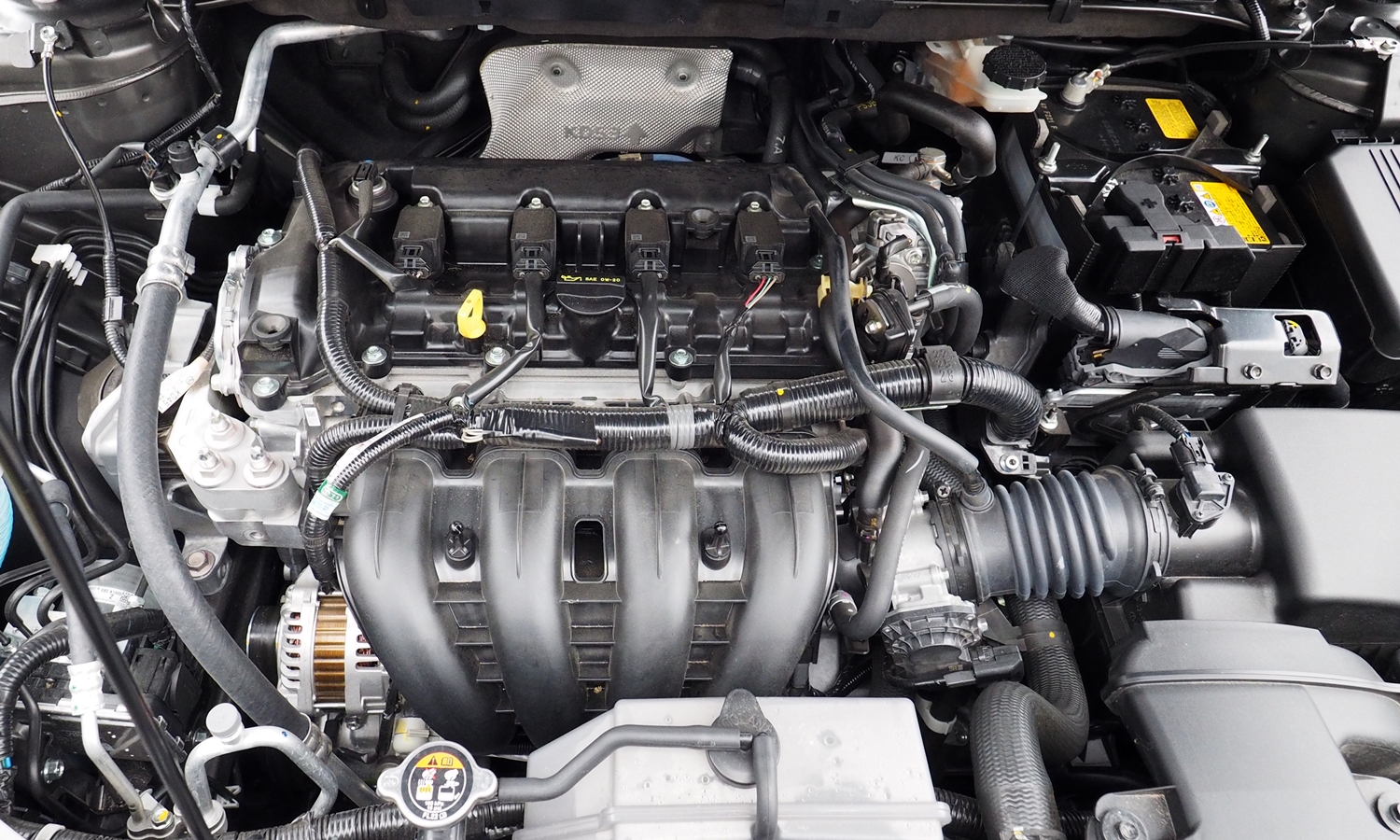
Good but not great power and economy. Engine noise is the least refined aspect of the new CX-5.
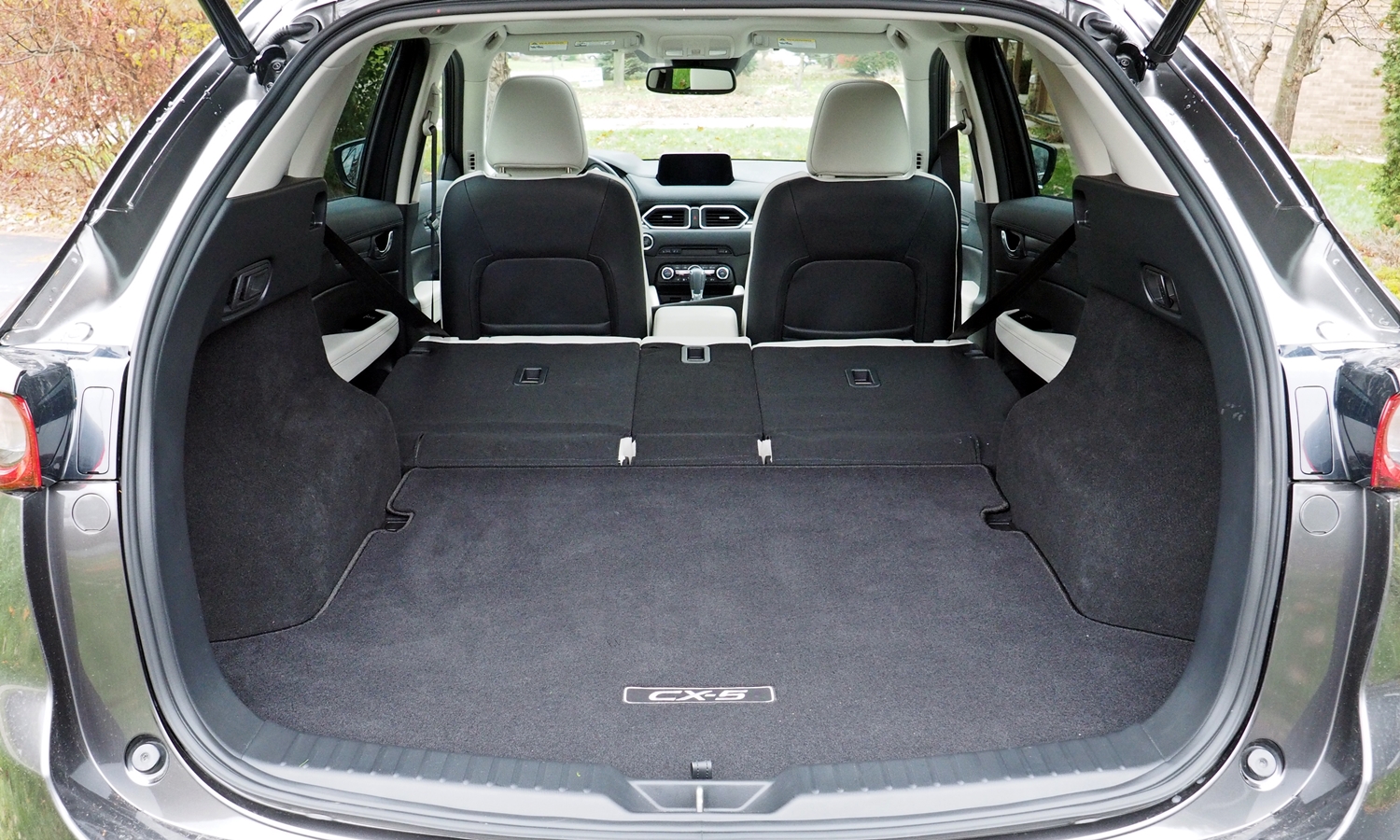
Less cargo space than in many competitors. But possibly all you need.
See more 2017 Mazda CX-5 photos
Mazda provided an insured CX-5 for a week with a tank of gas. Honda and Chevrolet provided cars at a regional media association event. Dan Kelley of Suburban VW in Farmington Hills, MI, helpfully provided a Tiguan (248-741-7903).











